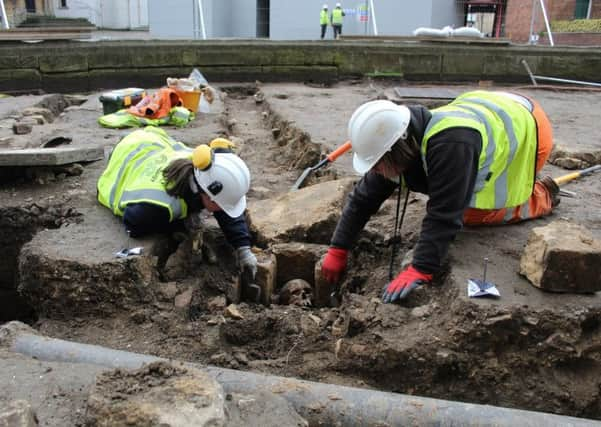Rare medieval priest burial among those found at Lincoln excavations


One of the many complete skeletons found is believed to be that of a medieval priest, who had been buried in the area that is now the building’s West Parvis.
His burial is just one of more than 50 found immediately around the cathedral; from the West Front at the main entrance to the Dean’s Green to north.
Advertisement
Advertisement
The excavations, by Lincoln-based Allen Archaeology Ltd, are part of the National Lottery-funded Lincoln Cathedral Connected project, which includes the delivery of vital restoration and renovation works to the iconic building, due to complete in 2022.


Lincoln Cathedral continues to be regarded as one of the most important cathedrals in the UK.
It has been standing over the city of Lincoln for more than 900 years, with building works commencing in 1072.
The connected project works to protect and safeguard the cathedral for generations to come and create new spaces for visitors of all ages to enjoy.
Advertisement
Advertisement
The Rev Canon John Patrick, Subdean of Lincoln, said: “The connected project is enabling us to not only protect and restore the cathedral but also to discover more about its history in terms of the buildings that stood here and the people who lived and worked here.


“We are always captivated by the many exciting objects that the archaeology team unearth during renovation works and the discovery of the priestly burial is significant.
“The finds really highlight the rich history of the religious site.
Canon Patrick continued: “The cathedral remains open while these works are taking place, and we are looking forward to welcoming more people to the cathedral and the new visitor’s’ centre this summer, where they will be able to view many of the artefacts for themselves.”
Advertisement
Advertisement
The priest’s burial was revealed during excavations to enable drainage works and landscaping around the cathedral.


He had been carefully buried with a pewter chalice and paten, used during communion and key symbols of the work of the priest.
These objects are quite plain in style and similar examples have been dated to as far back as the 12th and 13th centuries.
The area between the West Front of the cathedral and the neighbouring Exchequergate Arch is known to have been used as a burial ground for not only the cathedral but the church of St Mary Magdalene, in nearby Bailgate.
Advertisement
Advertisement
Part of the area of the Dean’s Green was also used as a burial ground for the cathedral, as were the many green spaces surrounding it.
However, it is not just skeletons that have been excavated during the project, with a host of fascinating historic artefacts currently being studied and dated.
It is planned that some of the items will be displayed as part of the new Lincoln Cathedral visitor centre, which is due to open this summer.
Other exciting finds from the excavations have included a hand from a statue, that may be from a very early frieze, and a coin depicting the face of Edward the Confessor, the last king of the House of Wessex, who ruled from 1042 to 1066.
Advertisement
Advertisement
The coin was minted between 1053 and 1056, and so pre-dates the building of the cathedral.
In the area of the new visitors’ centre (which is within a building previously used as a deanery), evidence has been uncovered of high-status Roman buildings – with highly decorated painted wall plaster, a near complete incense burner and a perfume jar among the notable finds, as well as a Roman spoon.
Some of the Roman wall plaster was painted with an intricate flowers and leaves design, while the rest features coloured bands.
The team believes they have plaster from three different rooms, some of which may be able to be reconstructed in the near future.
Advertisement
Advertisement
Senior manager at Allen Archaeology, Natasha Powers, said: “Since our work began on the cathedral as part of the connected project in 2016, we have uncovered significant evidence of Lincoln’s medieval, Saxon and Roman past.
“The objects we have found are not only beautiful and interesting in themselves, but, importantly, they enable us to better interpret the lives of those who occupied the city in previous centuries.”